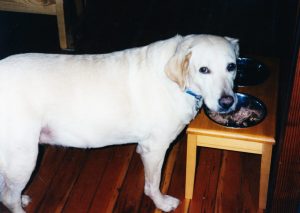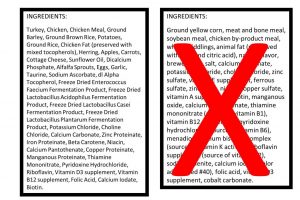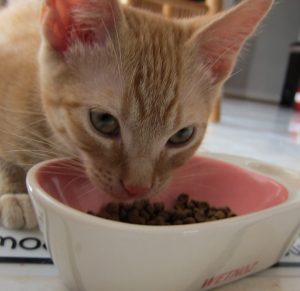 “You are what you eat.” Although this phrase has a contrived history dating back centuries, it didn’t emerge in English until 1940 when nutritionist Victor Lindlahr wrote the book so entitled expressing his strong belief that food controls health. It holds true for our canine and feline friends too.
“You are what you eat.” Although this phrase has a contrived history dating back centuries, it didn’t emerge in English until 1940 when nutritionist Victor Lindlahr wrote the book so entitled expressing his strong belief that food controls health. It holds true for our canine and feline friends too.
“Most consumers are unaware that the pet food industry got its early start in the marketplace as an opportunity to sell off waste from the human food industry,” explains Holistic Veterinarian Paula Terifaj. Shocking but true, contaminated and low quality sources of meat (animal by-products) that are rejected by the USDA (United States Department of Agriculture) are sold to pet food companies at bargain prices. These discarded ingredients can include intestines, udders, heads, hooves and even diseased and cancerous animal parts. But there is good news! “Fortunately, more progressive pet food companies are rejecting the use of inferior meat and grain by-products, are accepting only USDA-inspected meats and are not adding artificial flavorings and unnatural preservatives to their new diets,” says Dr. Terifaj. Therefore, one of the best things you can do for your dog or cat is to know what you are feeding him. To do so you must read and understand pet food labels and research the brand you buy.
BCDF (Before Commercial Pet Food)
Some eighty years ago, prior to the mass introduction of commercial dog and cat food, the family pet ate leftovers and table scraps in addition to scavenging and hunting. Whether our animals truly thrived on this diet is hard to say according to Deb Eldredge, DVM in Vernon, New York. “We keep better records now and have better diagnostics. I hear people say how years ago their dogs lived to age twenty with no health problems, but I honestly think the memories are a bit clouded.”
To this Susan Lauten, PhD and Pet Nutrition Consultant in Knoxville, Tennessee, adds, “Antibiotics and vaccines were not available [decades ago]. Dogs were grouped into the livestock category instead of being given a place in the family, so injury, illness, [neglect] and lack of veterinary care all served to shorten their life.”
INCREASED AWARENESS
The move towards healthier eating by people shows in the concern over our pet’s diet as well. Susan Blake Davis, a Certified Clinical Nutritionist who provides holistic pet health consultations nationwide, claims, “Many health-minded pet owners want the same high quality food for their pets that they eat themselves. While many are preparing homemade foods, others are demanding that the same quality be found in commercially prepared foods that are convenient and easy to use. As a result, there are lots of wonderful brands coming onto the market.” Dr. Terifaj however cautions not to be fooled by claims that pet foods labeled ‘balanced and nutritionally complete’ really are. “You are in a dangerous comfort zone if you believe that any one diet can be formulated [in that fashion.]” Every animal, like every individual human, is different with varying genetics, environments, sensitivities and needs. No one diet is perfect for all.
Additionally, the Menu Foods Recall of 2007 brought to light the fact that store bought pet food isn’t always safe and can be life-threatening. “With commercially prepared food,” explains Dr. Eldredge, “dogs are now getting a more balanced diet. In the past Veterinarians saw more cases of vitamin deficiencies or excesses, yet on the other hand, with the mass production of food, if a contaminated ingredient gets into the diet, we have large numbers of dogs throughout a wide area being affected.”
The 2007 Recall wasn’t the first but was the largest. In 1998 fifty-three brands of pet food were found to be contaminated with aflatoxin (a toxin produced by mold that can damage the liver) and ten more brands in 2005 and even more since.
HOW PET FOOD IS MADE
Although pet food manufacturers formulate their products to meet the guidelines established by the AAFCO (Association of American Feed Control Officials), the only mission of this organization is to guarantee the food meets a minimum of certain key nutrients – the minimal amount calculated to prevent known diseases due to deficiencies. But that doesn’t mean the ingredients promote health, and the guidelines do not specify the quality of ingredients, whether or not the proteins and carbohydrates have been tested for digestibility or how well your dog will actually absorb the nutrients. So…it is up to YOU, your pet’s caregiver, to make sure you are feeding the best diet for your dog’s ultimate health and well-being.
To make most kibble and semi-moist pet foods, ingredients are first blended according to a recipe. This dough is next fed into an extruder – a machine which produces continuous “ropes” of pet food.” The food is subjected to steam and high pressure, and then formed into shapes (think of the nozzles used for decorating cakes). As the hot, pressurized dough exits the extruder, it is cut into tiny pieces by rapidly moving knives (remember your childhood Playdough machine?). When the dough reaches normal air pressure, it puffs into shape, and when dried…may be sprayed with fat and preservatives to make it taste better and last longer.
Some brands,instead, bake their kibble at high temperatures (over 500 degrees Fahrenheit) into dense crunchy sheets which are later broken into irregular chunks. This type of kibble generally retains its flavor without the sprayed-on fats and others enhancers.
As for canned food, ground ingredients are mixed with additives. If chunks are needed for the recipe, a special extruder forms them. The mixture is cooked, canned and sent to your store shelf.

LABEL READING 101
There’s no way around it. To be a responsible pet parent, you must learn to read pet food labels to avoid buying an inferior product for your canine best friend. Some higher priced foods also contain undesirable ingredients, so don’t be fooled by the price tag or marketing campaign. Clever advertising gurus try to seduce you with photos of succulent meats and vegetables and happy puppy & kitty faces. Don’t judge food by its wrapper!
“Ingredients must be listed in descending order of weight, and animal protein is the single most important ingredient in dog food” states Dr. Terifaj. “Look at the first three ingredients listed to determine the main sources of protein being used. It is common practice to find that roughly 90% of pet foods are made up of the first three ingredients.” Dr. Eldredge suggests, “Pay attention if other items are broken into components. For example, if chicken is listed first, but then comes corn gluten, corn meal and ground corn, those three corn components may add up to a higher concentration than the chicken.”
Equally important as what you want to see on the label, are those items you do not want to see – chemical additives and preservatives. Below is a brief glossary of labeling “buzz” words to familiarize your self with:
All or 100% cannot be used (according to AAFCO guidelines) “if the product contains more than one ingredient, not including water sufficient for processing, decharacterizing agents [which color substandard meats to look more natural], or trace amounts of preservatives and condiments.”
95% Rule applies when the ingredients derived from animals, poultry or fish makes up 95% or more of the total weight of the product (or 70% excluding water for processing).
Flavor means the ingredients impart a distinctive characteristic to the food. Therefore, a “beef flavor” food may contain a small quantity of digest (material which results from a chemical or enzymatic process) or other extract of tissues or artificial flavor, without containing any actual beef meat at all.
Guaranteed analysis provides a very general guide to the composition of the food. Crude protein, fat, fiber and total moisture are required to be listed. Beware that the term crude protein allows pet food manufacturers to include items such as feathers, hair, hooves, tendons, and ligaments in their diets. While these animal by-products certainly contain protein, they are essentially indigestible and provide no nutritional value to your dog.
Holistic has yet to be embraced by regulations and standards with regards to pet food, so any manufacturer can claim the phrase on their packaging.
Human grade can be misleading unless the entire product is edible by humans, in accordance to USDA and FDA standards.
Organic means USDA rules and regulations must be followed and the product will have the USDA organic seal on the packaging.
Natural does not have an official definition but is construed to mean the product does not contain artificial flavors, artificial colors or artificial preservatives.
Premium, Super Premium, Ultra Premium and Gourmet labeled foods are not required to contain higher quality ingredients, nor are they held to higher nutritional standards than are any other product.
With, such as “with real chicken,” means that ingredient accounts for at least 3% of the food by weight, excluding water for processing.
FUTURE OF PET FOOD
The economy will at least partially determine what lies ahead in the pet food industry, but pet health experts see a definite trend towards home cooking – whether completely from scratch or by adding to a base commercial diet. Dr. Eldredge explains, “There are some basic diets now sold with the intention of having meat or eggs added to balance them. Dogs certainly enjoy a bit of yogurt or ground turkey added to their kibble.”
When adding raw vegetables to a meal, Dr. Terifaj suggests throwing the greens into a food processor to break down the cellulose (the cell wall of green plants) which helps your pet absorb the nutrients, but “Wash them first!” reminds Lauten, “and avoid onions, raisins, grapes, avocado and macadamia nuts, all of which can be toxic to your pets.” Lauten hopes there will be a move toward the use of whole fresh foods, canned and stew-type varieties that contain more protein.”
“With the raw food market expanding over the past decade as well as the arrival of packaged fresh frozen food (which do not require preservatives), it appears people are understanding the benefits and are getting back to basics for the health of their pets,” added professionals from Nutriment.co.uk.
WHO SHOULD DETERMINE WHAT FOOD IS BEST FOR YOUR PET?
YOU! You see your dog or cat everyday. You observe his energy level, condition of his coat, brightness of his eyes and general zest for life. Talk with your veterinarian, but realize not all veterinarians practice holistically – by means of preventive medicine which includes good health through proper nutrition. Seek out one who does. Dr. Terifaj confesses, “As Veterinary students we are conditioned early on in our training. Research done for the manufacturing of pet foods is used as course material to teach nutrition. Pet food companies fund and sponsor educational seminars to enforce the value of feeding their diets. We continue to receive information put out by these companies and our professional journals are plastered with ads touting the benefits of feeding specially formulated prescription diets for the treatment of various medical problems. In my veterinary practice, I have witnessed amazing transformations when dogs switched diets. Pets suffering from skin problems, gastrointestinal maladies, kidney failure, liver disease and cancer have experienced positive results.”
Choose the Best Food Your Budget Will Allow
It’s up to you to be your pet’s health care advocate. Do your research, pay attention to the results and enjoy a longer, healthier life with your four-legged best friend. Ignore packaging and clever names, but instead look at the actual ingredients. Much of the commercial food available today is made for the benefit of the consumer. It is made to be convenient, colorful and attractive. Orange carrot-shaped treats give consumers the false sense that they are giving their pet a real carrot.
Remember too that Mother Nature gives us our most basic rules: Eat fresh, choose variety and buy wholesome.
Here are some tips:
- Name the animal in the bag or can. The first two ingredients should be whole sources of animal proteins listed by type of meat: beef, chicken, lamb, salmon, venison or turkey. Avoid terms like meat proteins, poultry or fish since this allows the manufacturer to use wider variations of animal proteins that they are not then required to list (i.e.: poultry could mean turkey, duck, geese or any combination).
- If it’s not whole meat, stop reading the label. Meat by-products can include lungs, spleen, kidneys, brain, livers, blood, bone, stomachs and intestines. The good news…by-products do not include hair, horns, teeth and hooves.
- Steer clear of food with fillers. Grain products should be listed no higher up the label than third position and should be whole grains such as brown rice, barley and oatmeal. Processed fragments like rice flour and wheat flour and fillers such as corn, wheat gluten and gluten meals should not make the cut for your pooch.
- Stay away from additives. Used to enhance appearance and improve the taste, watch for food dyes (yellow #5, yellow #6 and red #3), sweeteners such as propylene glycol and sorbitol and additives like smoke or beef flavor and sodium nitrite which carry health risks.
- Avoid artificial preservatives such as BHA, BHT and ethoxyquin – all chemicals that have been questioned in terms of their long-term safety. Some premium pet foods are now using natural antioxidants like vitamins C, E and mixed tocopherols (sources of ‘E’) to slow down oxidation. Frozen foods avoid the use of unnatural preservatives altogether since freezing is a natural way to preserve food.

Additionally, realize that pet food is distributed and sold in various ways – chain pet stores, independent stores and via the internet, so you won’t find all brands in one location. Make time to explore your options for the health of your best friend!
Please also view my VLOG on this topic: https://youtu.be/GWhh0mxaeAY
__________________________________________________________
For 20 years Denise Fleck’s Sunny-dog Ink motto has been “Helping people to help their pets,” and she has…teaching more than 15,000 pet lovers animal life-saving skills and millions more on “The Doctors,” CNN, “Kirstie Alley’s Big Life,” Animal Planet and other TV shows. Denise is a frequent conference speaker, developed a line of pet first aid kits and now offers classes online.
Note: The articles on this page are copyrighted. Please do not reprint or use portions for any purpose without written permission from the author. Request permission for usage by sending an email explaining how you’d like to use the materials and what parts specifically. Thank you in advance!








